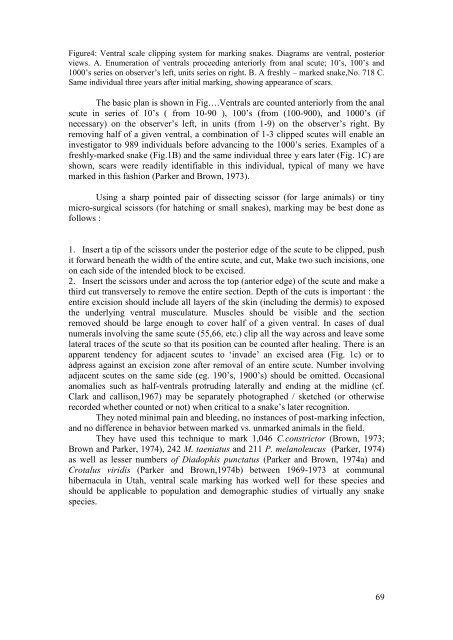standardization of records keeping in indian zoos - Central Zoo ...
standardization of records keeping in indian zoos - Central Zoo ...
standardization of records keeping in indian zoos - Central Zoo ...
Create successful ePaper yourself
Turn your PDF publications into a flip-book with our unique Google optimized e-Paper software.
Figure4: Ventral scale clipp<strong>in</strong>g system for mark<strong>in</strong>g snakes. Diagrams are ventral, posterior<br />
views. A. Enumeration <strong>of</strong> ventrals proceed<strong>in</strong>g anteriorly from anal scute; 10‟s, 100‟s and<br />
1000‟s series on observer‟s left, units series on right. B. A freshly – marked snake,No. 718 C.<br />
Same <strong>in</strong>dividual three years after <strong>in</strong>itial mark<strong>in</strong>g, show<strong>in</strong>g appearance <strong>of</strong> scars.<br />
The basic plan is shown <strong>in</strong> Fig….Ventrals are counted anteriorly from the anal<br />
scute <strong>in</strong> series <strong>of</strong> 10‟s ( from 10-90 ), 100‟s (from (100-900), and 1000‟s (if<br />
necessary) on the observer‟s left, <strong>in</strong> units (from 1-9) on the observer‟s right. By<br />
remov<strong>in</strong>g half <strong>of</strong> a given ventral, a comb<strong>in</strong>ation <strong>of</strong> 1-3 clipped scutes will enable an<br />
<strong>in</strong>vestigator to 989 <strong>in</strong>dividuals before advanc<strong>in</strong>g to the 1000‟s series. Examples <strong>of</strong> a<br />
freshly-marked snake (Fig.1B) and the same <strong>in</strong>dividual three y ears later (Fig. 1C) are<br />
shown, scars were readily identifiable <strong>in</strong> this <strong>in</strong>dividual, typical <strong>of</strong> many we have<br />
marked <strong>in</strong> this fashion (Parker and Brown, 1973).<br />
Us<strong>in</strong>g a sharp po<strong>in</strong>ted pair <strong>of</strong> dissect<strong>in</strong>g scissor (for large animals) or t<strong>in</strong>y<br />
micro-surgical scissors (for hatch<strong>in</strong>g or small snakes), mark<strong>in</strong>g may be best done as<br />
follows :<br />
1. Insert a tip <strong>of</strong> the scissors under the posterior edge <strong>of</strong> the scute to be clipped, push<br />
it forward beneath the width <strong>of</strong> the entire scute, and cut, Make two such <strong>in</strong>cisions, one<br />
on each side <strong>of</strong> the <strong>in</strong>tended block to be excised.<br />
2. Insert the scissors under and across the top (anterior edge) <strong>of</strong> the scute and make a<br />
third cut transversely to remove the entire section. Depth <strong>of</strong> the cuts is important : the<br />
entire excision should <strong>in</strong>clude all layers <strong>of</strong> the sk<strong>in</strong> (<strong>in</strong>clud<strong>in</strong>g the dermis) to exposed<br />
the underly<strong>in</strong>g ventral musculature. Muscles should be visible and the section<br />
removed should be large enough to cover half <strong>of</strong> a given ventral. In cases <strong>of</strong> dual<br />
numerals <strong>in</strong>volv<strong>in</strong>g the same scute (55,66, etc.) clip all the way across and leave some<br />
lateral traces <strong>of</strong> the scute so that its position can be counted after heal<strong>in</strong>g. There is an<br />
apparent tendency for adjacent scutes to „<strong>in</strong>vade‟ an excised area (Fig. 1c) or to<br />
adpress aga<strong>in</strong>st an excision zone after removal <strong>of</strong> an entire scute. Number <strong>in</strong>volv<strong>in</strong>g<br />
adjacent scutes on the same side (eg. 190‟s, 1900‟s) should be omitted. Occasional<br />
anomalies such as half-ventrals protrud<strong>in</strong>g laterally and end<strong>in</strong>g at the midl<strong>in</strong>e (cf.<br />
Clark and callison,1967) may be separately photographed / sketched (or otherwise<br />
recorded whether counted or not) when critical to a snake‟s later recognition.<br />
They noted m<strong>in</strong>imal pa<strong>in</strong> and bleed<strong>in</strong>g, no <strong>in</strong>stances <strong>of</strong> post-mark<strong>in</strong>g <strong>in</strong>fection,<br />
and no difference <strong>in</strong> behavior between marked vs. unmarked animals <strong>in</strong> the field.<br />
They have used this technique to mark 1,046 C.constrictor (Brown, 1973;<br />
Brown and Parker, 1974), 242 M. taeniatus and 211 P. melanoleucus (Parker, 1974)<br />
as well as lesser numbers <strong>of</strong> Diadophis punctatus (Parker and Brown, 1974a) and<br />
Crotalus viridis (Parker and Brown,1974b) between 1969-1973 at communal<br />
hibernacula <strong>in</strong> Utah, ventral scale mark<strong>in</strong>g has worked well for these species and<br />
should be applicable to population and demographic studies <strong>of</strong> virtually any snake<br />
species.<br />
69
















